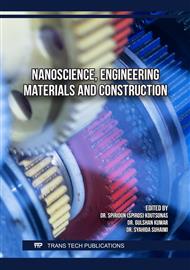p.3
p.11
p.21
p.29
p.39
p.51
p.59
p.79
Synthesis and Characterization of Anodic Alumina Oxide Using Oxalic Acid as Electrolyte Solution
Abstract:
Recently, demand for this Anodic Alumina Oxide (AAO) has been raised throughout the year due to its unique and special properties that will bring many benefits to the nanotechnology industry. AAO is the self-organized porous alumina produced by anodizing aluminum and can also be seen as nanotube arrays with honeycomb-like structures. Throughout these centuries, many research has been done in order to study the optimum parameter to produce high-quality AAO. This paper is specifically to investigate the effect of anodization voltage on the structural formation of AAO by using anodization of the aluminum process. A porous alumina template was prepared by using a difference voltage range of 20 V – 30 V in 0.3 M of oxalic acid; a copper wire was used as the cathode electrode and an aluminum template was used as an anode. It is observed that after the anodization process, there is a significant increase in current density at every voltage increment, as well as an increase in the size of the nanopores in AAO. The morphology and phase composition were characterized by using Field Emission Scanning Electron Microscope (FESEM), Energy Dispersive X-ray Spectroscopy (EDX) and Fourier Transform Infrared Spectroscopy (FTIR).
Info:
Periodical:
Pages:
11-18
Citation:
Online since:
April 2025
Keywords:
Price:
Сopyright:
© 2025 Trans Tech Publications Ltd. All Rights Reserved
Share:
Citation:


